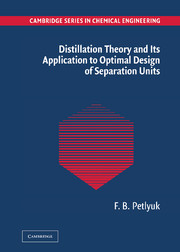Book contents
- Frontmatter
- Contents
- Preface
- Acknowledgements
- Nomenclature
- 1 Phase Equilibrium and Its Geometric Presentation
- 2 Basic Concepts of Distillation
- 3 Trajectories of Distillation in Infinite Columns Under Infinite Reflux
- 4 Trajectories of Thermodynamically Reversible Distillation
- 5 Distillation Trajectories and Conditions of Mixture Separability in Simple Infinite Columns at Finite Reflux
- 6 Distillation Trajectories in Infinite Complex Columns and Complexes
- 7 Trajectories of the Finite Columns and Their Design Calculation
- 8 Synthesis of Separation Flowsheets
- Short Glossary
- Index
- References
2 - Basic Concepts of Distillation
Published online by Cambridge University Press: 08 August 2009
- Frontmatter
- Contents
- Preface
- Acknowledgements
- Nomenclature
- 1 Phase Equilibrium and Its Geometric Presentation
- 2 Basic Concepts of Distillation
- 3 Trajectories of Distillation in Infinite Columns Under Infinite Reflux
- 4 Trajectories of Thermodynamically Reversible Distillation
- 5 Distillation Trajectories and Conditions of Mixture Separability in Simple Infinite Columns at Finite Reflux
- 6 Distillation Trajectories in Infinite Complex Columns and Complexes
- 7 Trajectories of the Finite Columns and Their Design Calculation
- 8 Synthesis of Separation Flowsheets
- Short Glossary
- Index
- References
Summary
Purpose and Process Essence of Distillation
Distillation is the oldest and the most universal process of chemical technology and other branches of industry incorporating separation of mixtures.
Practically, all natural substances and substances produced in the chemical reactors are mixtures that do not have the properties required for using them in techniques and for household needs. These mixtures should be separated into components or groups of components.
Distillation has substantial advantages over other processes applied in order to separate a mixture, such as extraction, crystallization, semipermeable membranes, etc. As a rule, it is the most cost-effective process, so it may be used for mixtures with very diverse properties. This process is based on the fact that the composition of the boiling liquid and that of the vapor over it differ. Thus, if the boiling temperature is low (e.g., air separation), it is necessary to use low-temperature refrigerants and conduct the process at a higher pressure. If it is high (e.g., in separation of heavy oil fractions or metals), high-temperature heat carriers or fire preheating have to be used and the process is run under vacuum.
If the composition of the boiling liquid and that of the vapor over it are quite close (e.g., xylene isomers or isotope separation), there is substantial energy consumption, which results in high capital costs.
It is impossible to conduct the distillation process in the case of azeotropic composition (i.e., if the composition of the boiling liquid and that of the vapor are identical).
- Type
- Chapter
- Information
- Publisher: Cambridge University PressPrint publication year: 2004



